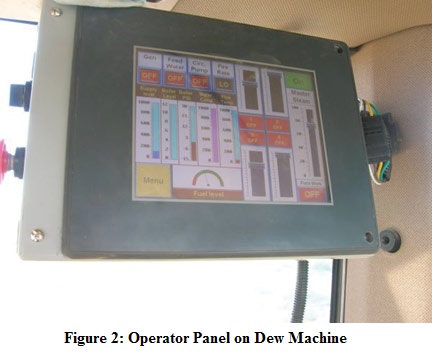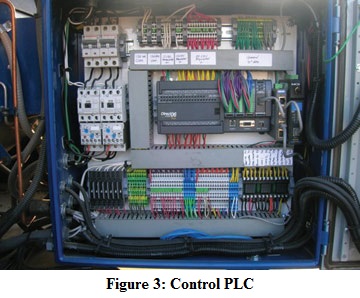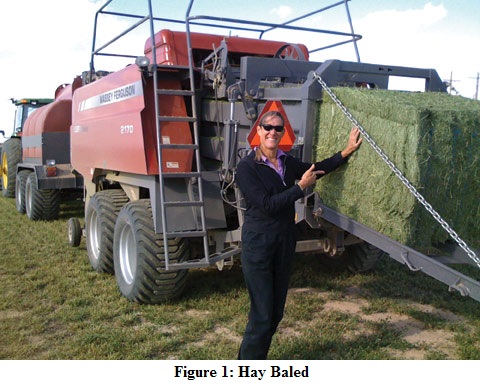A steam generating plant on wheels? That’s right. The DewPoint 6110 hooks up between a large farm tractor and hay balers that make large rectangular bales from 1,500 to 2,000 lb each (Fig. 1). Its purpose is to add moisture to dry hay to prevent mechanical damage to the crop during the baling process. This revolutionary concept, which has been successfully used and refined over the past 14 years, will change the way hay is made.
Growing high quality hay for the commercial market is one of the most important steps in the process of bringing meat, milk, cheese and other dairy products to the table. Huge machinery investments are made by hay growers and custom hay harvesters to ensure a successful harvest.
First, the hay is cut and laid into swaths or windrows for drying. After one to three days of drying the hay is raked, with two or more swaths or windrows being merged together into larger windrows for further drying in preparation for baling. On the fourth or fifth day the hay is fully cured and ready to bale.
However, one big problem exists at this point. When the hay is dry, it needs to be baled quickly to maintain the quality of the hay, and it needs to get off the field before the next rainstorm hits. Then why not just start baling?
Can’t Make Hay Without Water
To make good bales and prevent crop damage a little moisture must be introduced back into the dried windrows of hay so the leaves and stems of the crop remain intact as the hay is processed through the baler. Natural dew has been the primary source of this baling moisture. But, since the invention of the hay baler, hay growers have struggled to anticipate atmospheric conditions conducive to proper dew formation for baling hay.
If the dew is too light or if there is no dew, hay is damaged and a lot of the leaves are lost on the ground. If the dew is too heavy, the hay can’t be baled because it will spoil and there is a high risk of hay stack fires. The window of acceptable baling time typically ranges from zero to four hours a day, all depending on the whims of Mother Nature.
So how do farmers deal with making hay under such adverse conditions? Until now, they have been forced to purchase large quantities of equipment to cover lots of acreage quickly when conditions are favorable.
Commercial hay operations ordinarily have one tractor and a large rectangular baler for every 40-60 acres they want to bale each day. On a medium-sized hay farming operation of 2,000 acres, it’s common to see at least four of these machine combinations running to bale 150-200 acres a day. It’s an impressive sight, but at $250,000 each, it’s also very expensive. In a whole season each of these expensive machines might operate for fewer than 100 hours each, and that’s a very inefficient and costly way to run a farm.
Simulating Dew
The DewPoint 6110 is a steam dew simulation machine which, when coupled with one tractor and one baler, can replace up to four conventional tractor/baler combinations. The patented DewPoint technology enables commercial hay growers to bale hay anytime the crop is sufficiently dry without needing to wait for natural dew. Baling moisture levels can be accurately controlled in a wide variety of ambient conditions for 12-24 hours a day.
Here’s how it works:
1. Steam is produced by the DewPoint machine, a mobile steam generating plant, using a low pressure boiler supported by water tanks, a feed water system, fuel tanks, a generator and a PLC-based control system.
2. Steam is injected into the hay as it is lifted from the windrow by the baler pickup and as it passes through the feed chamber of the baler. Treatment of the hay is accomplished by injecting steam through a series of distribution manifolds mounted in the baler.
3. Bale temperature is monitored continuously and adjustments to the steam injection rate are made by the machine operator (Fig.2) as needed to maintain optimum bale moisture conditions at all times.
 The 2,000 acre hay operation can reduce its capital outlay to around $400,000 for hay baling equipment instead of $1,000,000. Labor expenses and machinery maintenance are also dramatically reduced, and the quality of the hay produced will be higher and much more consistent. Commercial hay farming operations with two or more large square balers are a natural fit for the DewPoint 6110.
The 2,000 acre hay operation can reduce its capital outlay to around $400,000 for hay baling equipment instead of $1,000,000. Labor expenses and machinery maintenance are also dramatically reduced, and the quality of the hay produced will be higher and much more consistent. Commercial hay farming operations with two or more large square balers are a natural fit for the DewPoint 6110.
Over the past 14 years, our commercial hay operation in arid western Utah has grown to nearly 2,000 acres. We use a John Deere 8410 tractor coupled to a DewPoint 6110 machine with one Massey Ferguson/Hesston 2170 3×4 large square baler. We can easily bale 200-250 acres each day in eight to ten hours with this setup. Several times we have baled 500 acres in a 24-hour period ahead of an expected rain with the wind howling and no
natural dew, and every bale has had ideal baling moisture.
The dew simulation machine allows you to schedule your harvests by the calendar, with the exception of rain. As long as the hay is dry enough, you can bale any time of the day or night.
Automation Makes It Possible
Automation has allowed us to make the machine very user friendly. All control functions are via an AutomationDirect (www.automationdirect.com) DirectLOGIC DL06 PLC mounted in a control panel that’s installed at the front of the machine (Fig. 3). We use an AutomationDirect C-more touch screen panel in the tractor cab to give the operator full control of the machine settings and functions from start-up to field operation to shut-down. There is a main overview screen, and the operator can drill down and see more detail via 20 other screens.

The PLC system automates the background processes, so the operator only has to start up the machine and manage the moisture content of the hay. Everything else is automatic, although operating conditions can be monitored as desired. Minor programming updates are made from time to time to streamline function and performance, and these updates are provided free of charge to our customers.
The PLC controls and monitors the machine via 30 discrete and 20 analog inputs and outputs. All I/O is local to the PLC and installed in expansion slots. The PLC is connected to the touch screen via Ethernet.
Conditions monitored by the PLC include boiler operating parameters, bale temperature and crop flow. Future plans call for the addition of bale moisture monitoring, allowing us to automatically close the moisture control loop.
The PLC uses the monitored inputs along with operator data entered via the touch screen to control steam application rate valves, the water systems and boiler functions.
When we first decided to automate, we had to decide which control system platform was the best fit. We selected AutomationDirect for a number of reasons.
First, the cost of their hardware and software is lower than competitors. Second, the technical support during the design phase and continuing on into initial deployment has been outstanding. The fact that the machine functioned almost without a hitch right out of the box attests to the professional assistance we received. Third, AutomationDirect offers a wide variety of components from a single source which easily integrate together. Integrating components from different vendors can be a major challenge, one that we wished to avoid.
Quantum Automation, in Anaheim, California, (www.quantumautomation.com) is our AutomationDirect Value Added Reseller. Since my first contact with Cynthia Snyder, our Quantum Automation rep, she and others at both Quantum and AutomationDirect have been extremely helpful in assessing our control system and providing professional assistance. We even got Cynthia up here to Cedar City last fall and taught her how to drive a big green tractor and bale hay with the DewPoint System. Due to its ease of use, she picked up on it right away!
Remote Diagnostics
We’ve also integrated a Moxa (www.moxa.com) OnCell Cellular IP modem remote monitoring system which allows us to connect to the machine’s control system via the Internet from any computer with an Internet connection. This feature allows us to provide direct technical assistance if the need arises, and also to provide alarm event notification.
Using the remote monitoring system – we can check machine functions, performance, and baled hay properties. We can also perform diagnostics, or even remotely operate the DewPoint 6110 machine from our office computer to assist operators.
We currently have diagnostic capabilities to check the many sensors on the machine for proper function. Some of these critical diagnostic functions are automated using comparative data from more than one sensor.
We are expanding the diagnostic capabilities this season, primarily through PLC program updates.
In large farming operations, remote monitoring can also allow a farm manager to watch and even control multiple DewPoint hay baling operations on his farm from a central computer. No additional software is needed, just an Internet connection into the control system via the remote cellular modem.
Another benefit of using cellular technology is that the modem has the ability to alarm if conditions arise which warrant alerting appropriate personnel. The PLC can send an output to one of two relays on the modem which will cause a text message to be sent to pre-defined phone numbers. Once a message is received, one can remotely log into that baler via any Internet browser and check the C-more screens to see what alarm conditions are occurring and to make appropriate corrections.
Seeing Is Believing
Based on our experiences, most people really can’t appreciate the effectiveness of the DewPoint without actually seeing it work. Most are skeptical and are very surprised when they see high quality hay baled in the middle of the afternoon.
The main issue slowing adoption of the dew simulation process over the past 14 years has been confidentiality restrictions. There were several hay symposium presentations given and articles published in trade magazines in 1997 and 1998. However, once a technology license was granted in 1998, publicity was stopped to allow research and development activities to continue under some cover.
Now with our system ready to enter the market, we welcome the opportunity to present it again, this time in a far more advanced and robust package ready for the rigors of commercial hay production. Quantum Automation and AutomationDirect have been great partners in our efforts and we look forward to working with them for many years to come.
We welcome anyone who wants to come and see the DewPoint 6110 in action, operate it or examine the hay produced by the process. For more information, call us at 435-590-2537. You can also visit our Web site for photos, videos, demonstration schedules and other information at www.StaheliWest.com.
By Dave Staheli
President, Staheli West
Originally Published: June 1, 2010


